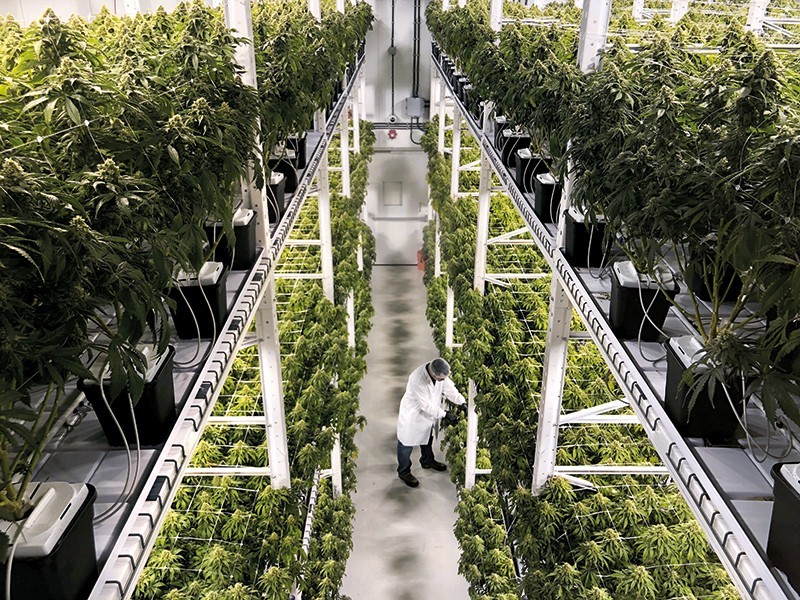Villanova Professor Addresses Energy Efficiency Issues in the Cannabis Industry

Cannabis Grow Facility
Less than two decades ago, marijuana was illegal in all 50 U.S. states. Today, in all but nine states, marijuana has either been decriminalized, legalized recreationally and/or made legal for medicinal purposes. Not surprisingly, the result has been a significant increase in the number of grow facilities. From 2012–2016, cannabis farms increased in number by 58%, cannabis plants by 183%, and the total area under cultivation by 91%. Growth in the number of sites (80%), as well as in site size (56% per site) contributed to the observed expansion. That growth, in turn, has had a substantial impact on energy use. By one estimate, grow facilities consume an estimated 1% of electricity in the US 1. In California, the top-producing state, that number rises to 3%5. While LED advancements have reduced the energy demands associated with lighting, a major source of electricity usage is air dehumidification, a requirement due to plant transpiration 2, 3. At Villanova University, Dr. Aaron Wemhoff, associate professor of Mechanical Engineering and director of Villanova’s Center for Energy-Smart Electronic Systems, is working with a grow facility HVAC equipment design firm, Surna Inc., in which they have agreed to review the project findings into new dehumidification technologies. He notes, “This project does not focus on promoting cannabis use or advancing the cannabis industry, but rather identifying opportunities for energy and carbon savings.”
“Grow facilities have unique air dehumidification challenges,” says Dr. Wemhoff. Traditional building HVAC systems dehumidify air as part of a cooling process. Alternatively, traditional agricultural air management systems draw in fresh outside air to replace the inside moist air. He explains, “Grow facilities are unique in that the traditional building HVAC approach is inefficient since the air would be over-cooled, and the traditional agricultural approach is infeasible because the airspace must be sealed to prevent outside contamination and to prevent the release of unpleasant odors.”
Working with Mechanical Engineering junior Tara Housen and with reviews by Surna, Dr. Wemhoff hopes to advance dehumidification technology specific to marijuana production facilities first by identifying the myriad technologies available and then examining their viability and stage of development. “This information will allow us to narrow our focus towards a specific technology that shows promise yet is at an appropriate level of development,” he says. “We will then disseminate this information to the grow facility industry and focus our efforts on one specific dehumidification technology.”
Dr. Wemhoff notes that the cannabis growth industry is still in its infancy, relying primarily on traditional approaches and rules of thumb and lacking significant early-stage fundamental research4. Research funding in this area has been historically sparse, both by governments due to political issues and by industry because of a lack of precedent. “The proposed work,” he says, “represents an important step forward in establishing Villanova as a center of expertise to improve energy efficiency within a major electricity consuming industry.”
1 E. Mills, “The Carbon Footprint of Indoor Cannabis Production,” Energy Policy, v. 46 (2012).
2 D.L. Jonlin and D.J. Lewellen, “A Low-energy High Managing Energy Use for Commercial Indoor Cannabis Cultivation,” Energy Engineering: Journal of the Association of Energy Engineering, v. 114 (2017), 69-79.
3 M.K. McGowan, “Load Calculations for Cannabis Grow Facilities,” ASHRAE Journal, v. 62(4) (2020), 83-87.
4 M. Christianson, C. Smith, K. Redding, and A. Scherba, “Indoor Cannabis Growing – Taming the Wild West,” Energy350.
5 J. Durkay and D. Freeman, “Electricity Use in Marijuana Production,” National Conference of State Legislatures, v. 24(31) (2016).
6 Van Butsic et al., “The emergence of cannabis agriculture frontiers as environmental threats,” Environ. Res. Lett., vol. 13 (2018), 124017.
